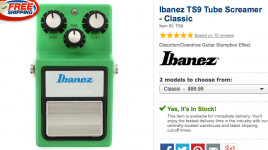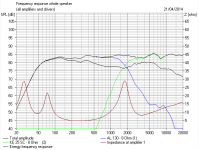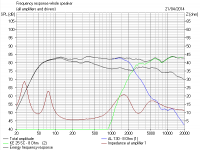Hi Guys,
I have build myself a set of nice two way speakers with visaton bass and tweeters.
They sound very nice and I really love them, but wan't more!
When I play load they are really crispy. Voices sounds much more potent/crispy. It is like they change character when played loud.
I wan't this crispyness when played low, or at least less loud.
I know that different frequencies aren't interpret the same way (by humans) with varying dB, so maybe this is something to look into - maybe try to boost the mids a little bit (there's a small low in the 1k-1,5k area).
I can try to make an in room measurement, but do you have any ideas of what is needed to get this crispiness played a little less loud?
All your input is much apprieciated!
I have build myself a set of nice two way speakers with visaton bass and tweeters.
They sound very nice and I really love them, but wan't more!
When I play load they are really crispy. Voices sounds much more potent/crispy. It is like they change character when played loud.
I wan't this crispyness when played low, or at least less loud.
I know that different frequencies aren't interpret the same way (by humans) with varying dB, so maybe this is something to look into - maybe try to boost the mids a little bit (there's a small low in the 1k-1,5k area).
I can try to make an in room measurement, but do you have any ideas of what is needed to get this crispiness played a little less loud?
All your input is much apprieciated!
My guess is that distortion gets high at some frequency ranges, when you play loud. Usually it is the tweeter's low end. Bass low end distortion is not so disturbing even though it usually is higher. If you are using aluminium woofer, it can also be it's cone resonance and 3rd harmonic distortion.
Which drivers are you using, what kind of crossover order and frequency?
Try to measure distortion with normal level and 10db louder! You will see where distortion areas are. REW and Holmimpulse are good freeware.
Which drivers are you using, what kind of crossover order and frequency?
Try to measure distortion with normal level and 10db louder! You will see where distortion areas are. REW and Holmimpulse are good freeware.
Last edited:
My guess is that distortion gets high at some frequency ranges, when you play loud. Usually it is the tweeter's low end. Bass low end distortion is not so disturbing even though it usually is higher. If you are using aluminium woofer, it can also be it's cone resonance and 3rd harmonic distortion.
Which drivers are you using, what kind of crossover order and frequency?
Try to measure distortion with normal level and 10db louder! You will see where distortion areas are. REW and Holmimpulse are good freeware.
Read again 🙂
Read again 🙂
Ok - to get more distortion even at low volume???
It is a well known fact that many people prefer a bit distorted sound (even order harmonics), they might call it more natural or musical... I am just trying to guess what is making these speakers to sound "more potent/crisp" at high levels. The only parameter of a speaker that changes with voltage/spl is distortion.
One explanation to high spl being sensed more potent is human hearing, namely Fletcher-Munson curve and loudness effect. But this is universal, not spesific to any speaker.
tued, try just adjusting bass and treble (or better some parametric eq) to examine if you can change the sound better that way!
Last edited:
A pair of TS9 in the tape loop or in series before the amp will add all the "crispiness" you could ever want 😉I can try to make an in room measurement, but do you have any ideas of what is needed to get this crispiness played a little less loud?
Aphex Aural Exciters also add "pleasing" distortion with a slightly more subtle effect, aspiring DJs often use them..
Attachments
do you have any ideas of what is needed to get this crispiness played a little less loud?
Look up the "aural exciter", you may like it, or maybe not 😉
Some set ups come alive at higher volumes. But if you have to go high enough so that your introducing distortion to make it sound good I would suspect a mismatch somewhere. Distortion from straining components isn't appealing to me. What is the efficiency and ohm rating of the speakers and the amplifiers capabilities.
Last edited:
The drivers are two AL-130 and a KE 25 SC tweeter. All Visaton.
They are crossed at about 1,5kHz. The woofer is crossed using a 2nd order filter and the tweeter with a first order.
The tweeter is mounted in a waveguide to get the extra extention in the low end.
Whether it is distortion or the Fletcher-Munson curve that is the important factor I do not know -> hence this post.
Fact is that I (and I'm not alone with this opinion) find the sound much more pleasing when played loud (not just the fact that it is loud).
I've tried a little EQ with the Dirac app (just the trial for now), but that didn't to the trick. It resulted in a better upper bass response; which is very nice, but not what I'm looking for in this post.
I'm flying a little blind here, so if anybody have some good pointers they'll be much appriciated.
They are crossed at about 1,5kHz. The woofer is crossed using a 2nd order filter and the tweeter with a first order.
The tweeter is mounted in a waveguide to get the extra extention in the low end.
Whether it is distortion or the Fletcher-Munson curve that is the important factor I do not know -> hence this post.
Fact is that I (and I'm not alone with this opinion) find the sound much more pleasing when played loud (not just the fact that it is loud).
I've tried a little EQ with the Dirac app (just the trial for now), but that didn't to the trick. It resulted in a better upper bass response; which is very nice, but not what I'm looking for in this post.
I'm flying a little blind here, so if anybody have some good pointers they'll be much appriciated.
Some set ups come alive at higher volumes. But if you have to go high enough so that your introducing distortion to make it sound good I would suspect a mismatch somewhere. Distortion from straining components isn't appealing to me. What is the efficiency and ohm rating of the speakers and the amplifiers capabilities.
The amp is an Arcam AVR300 with 100 watts per channel, so that you be enough.
What I'm looking for is how to make them "come a live" at lower SPL's 🙂
A "waveguide" does not likely give extra low end extension, but may increase level by +3 dB or so.
The tweeter's acoustic crossover may be lower or higher than 1500 Hz, measurements would confirm that, but assuming a 1500 Hz crossover, at higher levels when nearing the excursion maximum harmonics will be generated at 3 kHz, 4.5 kHz, 6 kHz, 7.5 kHz, 9 kHz, 10.5 kHz, 12 kHz, etc.
The second and third harmonics are centered near the frequency where normal hearing is most sensitive (4 kHz) so a little distortion there can go a long ways.
Many of the "classic rock" vocals were recorded with Aphex devices (their design was secret, components potted over, and only leased) that add upper harmonics, so whatever opinion one has on distortion, most of us listen to a lot of it, and modern pop music has no shortage of it in dozens of flavors.
Of course, whether you desire to add even more (or more odd) distortion is up to you.
I think you should model them: Downloads
The Bijou file is available: Boxsim Projektdatenbank Bijou.
You just import it into "Projekte" folder in Boxsim.
I've heard good things about the KE25SC tweeter. But it is surely going to struggle on a first order filter at 1.5kHz crossover. Looks like the Bijou is a bit bass light, so with the "Fletcher Munson" curve applied would improve at high volume.
Truthfully, I'd guess the tweeter and metal woofer is distorting a lot at high volume. It seems, strangely, like you like that sound. Fs notches, like the one built into the KE25SC don't work that well IMO. They let through a lot of bass into the tweeter. If you think about it, an LCR lets through a lot more subsonics than a coil. Because the capacitor turns the filter into first order at low frequency.
Perhaps you could redesign them for a gentle downward slope overall. They used to call that the BBC slope, and it sounds very smooth. I'd use a third order tweeter filter too if it all works out on phase.
The Bijou file is available: Boxsim Projektdatenbank Bijou.
You just import it into "Projekte" folder in Boxsim.
I've heard good things about the KE25SC tweeter. But it is surely going to struggle on a first order filter at 1.5kHz crossover. Looks like the Bijou is a bit bass light, so with the "Fletcher Munson" curve applied would improve at high volume.
Truthfully, I'd guess the tweeter and metal woofer is distorting a lot at high volume. It seems, strangely, like you like that sound. Fs notches, like the one built into the KE25SC don't work that well IMO. They let through a lot of bass into the tweeter. If you think about it, an LCR lets through a lot more subsonics than a coil. Because the capacitor turns the filter into first order at low frequency.
Perhaps you could redesign them for a gentle downward slope overall. They used to call that the BBC slope, and it sounds very smooth. I'd use a third order tweeter filter too if it all works out on phase.
I'd consider revising the crossover.
My Behringer B2031Ps use a similar principle, but aim for a 2.5kHz acoustic crossover. Zaph's measurements suggest the electrical crossover may be higher, as the waveguide does add more at the bottom end than the top (my guess is beaming toward the VHF, so the tweeter doesn't see the waveguide). The Behringers also have some quite obvious harmonic distortion in the midrange when pushed hard. The active versions should be better in that respect, with their 4th order crossovers.
Chris
My Behringer B2031Ps use a similar principle, but aim for a 2.5kHz acoustic crossover. Zaph's measurements suggest the electrical crossover may be higher, as the waveguide does add more at the bottom end than the top (my guess is beaming toward the VHF, so the tweeter doesn't see the waveguide). The Behringers also have some quite obvious harmonic distortion in the midrange when pushed hard. The active versions should be better in that respect, with their 4th order crossovers.
Chris
Hi,
I know of no 1" dome tweeter that can do 1st order electrical at 1.5KHz.
Model it in Visatons free Boxsim program. An Fs impedance notch does
what it does and I can't make any sense of S7's comments at all.
They do work well, its pointless to say they don't, and being a
parallel network, it has no effect on the signal to the tweeter.
Without distortion curves for the tweeter your flying blind.
2KHz 4th order L/R acoustic is as good a target as any.
Look at this : http://www.zaphaudio.com/audio-speaker17.html
rgds, sreten.
http://audio.claub.net/Simple Loudspeaker Design ver2.pdf
http://www.rjbaudio.com/Audiofiles/FRDtools.html
http://web.archive.org/web/20090902124715/http://geocities.com/woove99/Spkrbldg/DesigningXO.htm
I know of no 1" dome tweeter that can do 1st order electrical at 1.5KHz.
Model it in Visatons free Boxsim program. An Fs impedance notch does
what it does and I can't make any sense of S7's comments at all.
They do work well, its pointless to say they don't, and being a
parallel network, it has no effect on the signal to the tweeter.
Without distortion curves for the tweeter your flying blind.
2KHz 4th order L/R acoustic is as good a target as any.
Look at this : http://www.zaphaudio.com/audio-speaker17.html
rgds, sreten.
http://audio.claub.net/Simple Loudspeaker Design ver2.pdf
http://www.rjbaudio.com/Audiofiles/FRDtools.html
http://web.archive.org/web/20090902124715/http://geocities.com/woove99/Spkrbldg/DesigningXO.htm
Last edited:
I've already Modeled them in boxsim. Nice program.
Can it tell me anything about the distortion or should I measure that?
I've used REW a little, but haven't found any graph that tells me much about the measures distortion.
Any pointers?
Sent from my iPhone using Tapatalk
Can it tell me anything about the distortion or should I measure that?
I've used REW a little, but haven't found any graph that tells me much about the measures distortion.
Any pointers?
Sent from my iPhone using Tapatalk
By the way. I have the UMK-1 mic from minidsp as well as their calibration file.
So all it takes is time, which is sparse as always ;-)
Sent from my iPhone using Tapatalk
So all it takes is time, which is sparse as always ;-)
Sent from my iPhone using Tapatalk
good 'resolution' is always tricky to achieve
and the difficulties are all over the place from source and amps to the speakers
what you hear now at louder SPL is a fiction of it, and not the real thing
and the difficulties are all over the place from source and amps to the speakers
what you hear now at louder SPL is a fiction of it, and not the real thing
Hi,
Like I said 2KHz 4th order acoustic is a reasonable
target to sensibly avoid distortion in the treble unit.
And no, sims don't do distortion stuff, except Xmax.
rgds, sreten.
Like I said 2KHz 4th order acoustic is a reasonable
target to sensibly avoid distortion in the treble unit.
And no, sims don't do distortion stuff, except Xmax.
rgds, sreten.
Read my lips. Third order butterworth tweeter filter is better than first order plus FS notch. Less subsonics to cause distortion! 😀
Reasons here: http://www.diyaudio.com/forums/multi-way/97043-elsinore-project-thread-175.html#post3895980
I just ran this past Boxsim using Troels' filter for the similar SEAS W15CY001:
SEAS 5INCH
He uses a much higher crossover. I took it up a tidge myself with a smaller bass capacitor and it all seemed to work. I added a 33R/0.22uF tank to the bass coil to notch the breakup too.
As it goes, I think I had something round 4.7uF/0.4mH/4.7uF for the tweeter which is the correct form for butterworth with a 6R resistor in front.
Reasons here: http://www.diyaudio.com/forums/multi-way/97043-elsinore-project-thread-175.html#post3895980
I just ran this past Boxsim using Troels' filter for the similar SEAS W15CY001:
SEAS 5INCH
He uses a much higher crossover. I took it up a tidge myself with a smaller bass capacitor and it all seemed to work. I added a 33R/0.22uF tank to the bass coil to notch the breakup too.
As it goes, I think I had something round 4.7uF/0.4mH/4.7uF for the tweeter which is the correct form for butterworth with a 6R resistor in front.
Attachments
Hi,
The Fs notch has nothing to to do with the veracity of the crossover.
1st order is always going to be poor, and unworkable without the
the Fs notch, but still a poor choice. If fitted there is no point in
removing it, and in this case looks to me me 2nd order electrical
can hit near 4th order acoustic L/R around 2KHz.
"Read my lips " ? IMO in this is case very poor exposition,
and trying to make out what you said is something else.
Which doesn't change what you said is nonsense.
rgds, sreten.
The Fs notch has nothing to to do with the veracity of the crossover.
1st order is always going to be poor, and unworkable without the
the Fs notch, but still a poor choice. If fitted there is no point in
removing it, and in this case looks to me me 2nd order electrical
can hit near 4th order acoustic L/R around 2KHz.
"Read my lips " ? IMO in this is case very poor exposition,
and trying to make out what you said is something else.
Which doesn't change what you said is nonsense.
rgds, sreten.
Last edited:
- Status
- Not open for further replies.
- Home
- Loudspeakers
- Multi-Way
- Why are my two-way visaton more crispy at high volume?


